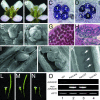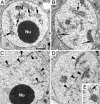The Arabidopsis AtRAD51 gene is dispensable for vegetative development but required for meiosis
- PMID: 15249667
- PMCID: PMC489980
- DOI: 10.1073/pnas.0404110101
The Arabidopsis AtRAD51 gene is dispensable for vegetative development but required for meiosis
Abstract
The maintenance of genome integrity and the generation of biological diversity are important biological processes, and both involve homologous recombination. In yeast and animals, homologous recombination requires the function of the RAD51 recombinase. In vertebrates, RAD51 seems to have acquired additional functions in the maintenance of genome integrity, and rad51 mutations cause lethality, but it is not clear how widely these functions are conserved among eukaryotes. We report here a loss-of-function mutant in the Arabidopsis homolog of RAD51, AtRAD51. The atrad51-1 mutant exhibits normal vegetative and flower development and has no detectable abnormality in mitosis. Therefore, AtRAD51 is not necessary under normal conditions for genome integrity. In contrast, atrad51-1 is completely sterile and defective in male and female meioses. During mutant prophase I, chromosomes fail to synapse and become extensively fragmented. Chromosome fragmentation is suppressed by atspo11-1, indicating that AtRAD51 functions downstream of AtSPO11-1. Therefore, AtRAD51 likely plays a crucial role in the repair of DNA double-stranded breaks generated by AtSPO11-1. These results suggest that RAD51 function is essential for chromosome pairing and synapsis at early stages in meiosis in Arabidopsis. Furthermore, major aspects of meiotic recombination seem to be conserved between yeast and plants, especially the fact that chromosome pairing and synapsis depend on the function of SPO11 and RAD51.
Figures






References
-
- Hickson, I. D. (2003) Nat. Rev. Cancer 3, 169–178. - PubMed
-
- Lieber, M. R., Ma, Y., Pannicke, U. & Schwarz, K. (2003) Nat. Rev. Mol. Cell Biol. 4, 712–720. - PubMed
-
- Game, J. (2000) Mutat. Res. 451, 277–293. - PubMed
-
- Thacker, J. (1999) Trends Genet. 15, 166–168. - PubMed
-
- Haber, J. (2000) Trends Genet. 16, 259–264. - PubMed
Publication types
MeSH terms
Substances
Grants and funding
LinkOut - more resources
Full Text Sources
Other Literature Sources
Molecular Biology Databases
Research Materials

